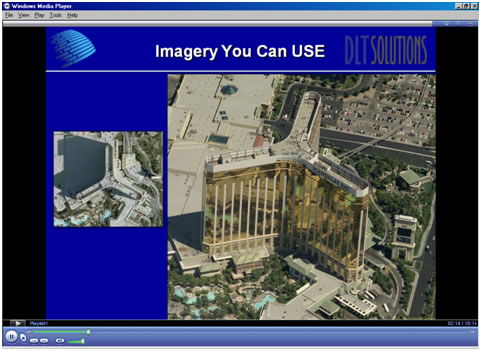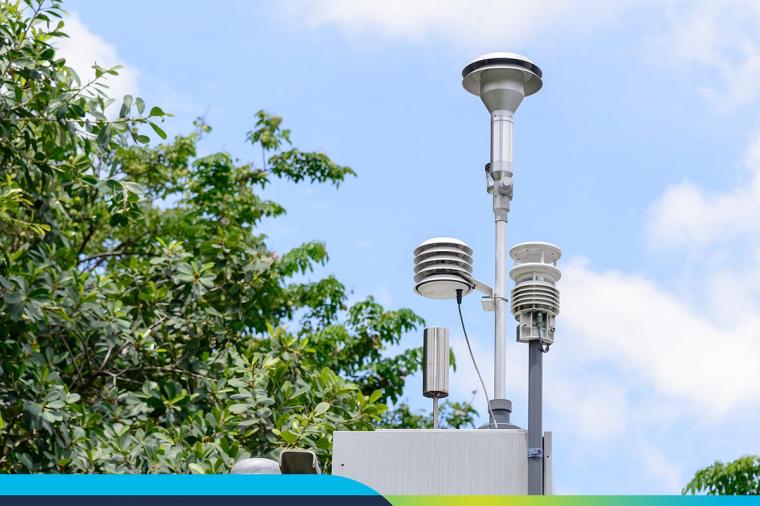Oblique vs Orthogonal Imagery: Which one is better?
Acronym and DLT Solutions recently hosted a webinar with Dan Whalen from Lockheed Martin on their Intelligence on Demand (IoD) solution. One of the key takeaways of the webinar answered the question as to why oblique imagery is more useful and actionable than orthogonal imagery.
If you’re not already familiar, orthogonal images are straight-down shots of buildings and points of interest from a long range satellite orbiting the earth. Oblique images on the other hand, like those provided by IoD, are taken at a 40 degree angle from a low flying aircraft equipped with a five camera system that rapidly captures images from all cardinal directions. This provides a much clearer and identifiable image.
Below is a depiction of the difference between an orthogonal image and an oblique image. The oblique image is on the left.
 Intelligence on Demand allows you access to over 130 million, geospatially accurate oblique images. Through the IoD interface, you can measure the distance, height and/or area of an image as well as make annotations that you can share with colleagues. A map is included with every image and IoD is compatible with other products like Google Earth, ESRI and mobile devices.
You can learn more about how oblique imagery provided by Intelligence on Demand can help you plan field operations, support ongoing operations and even conduct post-event assessments and reviews with the Introduction to Intelligence on Demand Archived Webcast.
After you view the archived webcast, let us know which one you think is better for your operations?
Related posts:
Intelligence on Demand allows you access to over 130 million, geospatially accurate oblique images. Through the IoD interface, you can measure the distance, height and/or area of an image as well as make annotations that you can share with colleagues. A map is included with every image and IoD is compatible with other products like Google Earth, ESRI and mobile devices.
You can learn more about how oblique imagery provided by Intelligence on Demand can help you plan field operations, support ongoing operations and even conduct post-event assessments and reviews with the Introduction to Intelligence on Demand Archived Webcast.
After you view the archived webcast, let us know which one you think is better for your operations?
Related posts:
 Intelligence on Demand allows you access to over 130 million, geospatially accurate oblique images. Through the IoD interface, you can measure the distance, height and/or area of an image as well as make annotations that you can share with colleagues. A map is included with every image and IoD is compatible with other products like Google Earth, ESRI and mobile devices.
You can learn more about how oblique imagery provided by Intelligence on Demand can help you plan field operations, support ongoing operations and even conduct post-event assessments and reviews with the Introduction to Intelligence on Demand Archived Webcast.
After you view the archived webcast, let us know which one you think is better for your operations?
Related posts:
Intelligence on Demand allows you access to over 130 million, geospatially accurate oblique images. Through the IoD interface, you can measure the distance, height and/or area of an image as well as make annotations that you can share with colleagues. A map is included with every image and IoD is compatible with other products like Google Earth, ESRI and mobile devices.
You can learn more about how oblique imagery provided by Intelligence on Demand can help you plan field operations, support ongoing operations and even conduct post-event assessments and reviews with the Introduction to Intelligence on Demand Archived Webcast.
After you view the archived webcast, let us know which one you think is better for your operations?
Related posts:
Related Blog Posts
Business Applications, Digital Design
Transition periods are never easy. As businesses move from routine practices to uncertain situations, there’s a level of trepidation involved. Thankfully, there are ways to ease this anxiety—namely, by shedding light on the gap in old vs. new practices. At a time when many organizations are either in the middle of transition or running up against it, investment in visibility is imperative.
Nowhere is visibility more important than facility planning. Facility managers need oversight as they begin to adapt assets and workflows in the near-term and for the future.
Michael Willette
Business Applications, Digital Design
The COVID-19 pandemic has been disruptive to physical workplaces for so many reasons. One of the biggest challenges for businesses has been adapting offices to new and often equally disruptive safety standards – social distancing, sanitization, contact tracing, etc. While there’s keen emphasis on these practices, indoor air quality (IAQ) in many offices is only now getting the attention it deserves.
Michael Willette
Digital Design
Healthcare facility management is complex, especially since many organizations are open around the clock. Ensuring yours is at its best is expensive. Maintaining a building properly accounts for more than 80 percent of the total cost of operations and occupancy. Safety regulations constantly change. Patients arrive and depart on a variety of timelines. Healthcare workers regularly use spaces like break rooms and storage areas.
Michael Willette
Big Data & Analytics, Channel Partners, Digital Design
Does your business have a single source of truth when it comes to data sharing across facilities? Ensuring data is accurate, relevant, and structured is something any business can recognize as important, yet it is more difficult to achieve than most realize. Just because you are use an integrated workplace management system (IWMS) or have relevant GIS data doesn’t mean it provides a single source of truth.
Michael Willette
Channel Partners, Digital Design
This interview was originially posted by GovDesignHub here.
Brandon Norris
Digital Design
Article authored by Dan Williams and originally posted to GovDesignHub here.
On April 6, 2021, Autodesk Vault 2022 was released. And I have to say that it is easily the most feature-rich release in recent memory.
Brandon Norris
Digital Design
Prior to 3D printing’s arrival on the manufacturing scene, the US military supply chain was often met with lengthy and arduous timelines for critical asset production. This not only stalled the manufacture and repair of essential equipment within the military supply chain, but it also impeded military readiness, and with high price tags to boot.
Brandon Norris
Channel Partners, Digital Design
Americans spend about 90% of their time indoors, according to EPA reports. Whether it is their home, workplace, or another location, people depend heavily on a controlled environment. Everything from the air we breathe to the light we bask in is artificial or at least managed. In shared spaces, it is the responsibility of building owners and managers to provide healthy and safe workplaces.
Carly Bell
Digital Design
Out of sight, out of mind. It’s all too easy to forget about asset maintenance when the assets themselves aren’t right in front of you. During the COVID-19 pandemic, this became more evident as employees went home and logged into a virtual workplace instead of coming to a physical space.
Carly Bell
Digital Design
There are two distinct factions when it comes to working from home: those who relish it and those who despise it. Before COVID-19, working from home was a perk. When the pandemic hit, work-from-home (WFH) became a necessity to combat the virus’s spread. One person’s dream; the other’s nightmare.
As COVID-19 rolls on, employers are dealing with two sides of a war between those who want to return to the office and those who’d prefer working from home. Depending on who you ask, results are mixed:
Carly Bell
Digital Design
The modern workplace is a far cry from spaces of the past. Banks of private offices gave way to an open concept fad that’s morphed into a hybrid of spaces, including personal desks surrounded by pony walls, hot and hotel desks, and collaboration areas.
COVID-19 threw workplace and space management into turmoil, but the return-to-work movement is underway. As employees come back to offices, stores, factories, and other businesses, the need for privacy in the workplace again takes center stage.
Carly Bell
Digital Design
Mixed-use spaces – used by public sector agencies for different purposes – or even mixed-use cities present unique challenges for workplace managers under the cloud of COVID. Unlike single-use facilities, mixed-use spaces may see much larger groups of people come and go. Monitoring the health of every individual is likely impossible without strict contact tracing standards.
Carly Bell
Digital Design
Historic buildings hold a special place in the hearts of architects, workplace planners, and employees. There’s something alluring about creating workspaces within the confines of century-old stone or retrofitting a Victorian Era home into offices.
For all their uniqueness, repurposing historic buildings for modern workplaces isn’t as easy as replacing a few light fixtures and brushing on a new coat of paint. Most older structures are governed by sometimes-strict regulations overseen by historic districts – the first was created in South Carolina in 1931.
Carly Bell
Digital Design
Article originally posted to the GovDesignHub here.
Brandon Norris
Digital Design
Article originially posted to the GovDesignHub here.
Brandon Norris
Digital Design
One of the many challenges that organizations faced this year was the scaling of a remote work model. But with the prospect of life and work returning to normal in the coming months, those same organizations face a new challenge – scaling back up their facilities in a safe way.
To learn more about how facilities and space managers are planning for this prospect, I sat down for a Q&A with Nick Stefanidakis, Vice President of Field Sales & Enablement at SpaceIQ.
Brandon Norris
Digital Design
The benefits of the Internet of Things (IoT) are undeniable. IoT-enabled technologies collect data that impacts cost, productivity, compliance, and security. However, that data is only as good as the analyses derived from it, especially when it’s connected to how workplaces are populated, and space is managed today and in the future.
Carly Bell
Digital Design
Managing real estate for a single workplace is, in certain ways, simple. There is a single set of data for land, buildings, and leases. For companies with multiple properties or a global presence, the task becomes daunting.
A centralized data repository is the key to maintaining accurate and easily accessible information to manage real estate portfolios. But not all data systems are alike. Real estate planners and facility managers should consider several items when choosing a real estate portfolio management system:
Carly Bell
Digital Design
Let’s face it: the days of open offices are over. The pandemic likely drove the final nail in the coffin of a design fad that was all the rage but fails to meet the safety and productivity needs of today’s workplaces.
That’s no easy task in the face of a pandemic that shut the economy down for months and continues to wreak havoc. But employers are reopening workplace doors and welcoming employees back—and Archibus is ready to help with safe back-to-work transitions.
Carly Bell
Digital Design, IT Infrastructure
The more things change, the more they stay the same— especially when it comes to budgets and requirements. How does one keep up with it all?
It is crucial to track, manage, and analyze property and infrastructure information to maintain or reduce operational costs.
Here are a few tips to help you get the most out of your IWMS and keep up with all the changes thrown your way.
1. Collect as much (accurate) data as possible
Carly Bell
Digital Design
Another release of Civil 3D just became available, just as you probably finished installing the latest 2020 “fix.” That was somewhat sarcastic, but I do some see much needed improvements to Autodesk Civil 3D 2021 and all other 2021 products. But we can’t just look at what’s new in our hero product, but all other complimentary products as well, so I will briefly mention a few of those.
Civil 3D Version Interoperability
DLT Solutions
Digital Design
A new version of AutoCAD is now available.
DLT Solutions
Digital Design
From design, construction, to facilities management, the need for closer ownership is clear.
Shaun Gaffrey
Digital Design
The future of government offices, buildings, and installations is about to change dramatically. When workers return to work or building owners make changes to how they work, they can expect offices to be designed differently to minimize the spread of germs and make people feel safe. But we can also expect sanitation to step up significantly.
Caron Beesley
Digital Design
Digital design data is a big data business. It requires secure management and storage, versions need to be stringently controlled, and teams need to access files readily so they can share that data with stakeholders.
For too long, however, designers, engineers, and CAD managers have relied on traditional document management systems, like network drives, to achieve this. While they do a great job with office documents, those same solutions don’t work well with today’s design files and models, for several reasons:
Caron Beesley
Digital Design
AutoCAD 2021 is here!
On March 25, 2020, Autodesk announced the release of AutoCAD 2021 the latest iteration of its flagship software first released in 1982. A key update includes a new integration with Google Drive allowing users to access their designs wherever they are as well as performance enhancements.
Let’s break down what’s new.
Caron Beesley
Digital Design
Article originally posted to GovDesignHub here.
If you’ve made the move from AutoCAD to Revit, congratulations. But what do you do with that huge library of details that you amassed over years of working on CAD projects? As you transition to Revit, recreating AutoCAD details is a hassle and trashing them is out of the question.
The good news is, you can use details right in your Revit project – straight from AutoCAD.
Caron Beesley
Digital Design
Article originally posted to GovDesignHub here.
Building and maintaining our nation’s infrastructure is a critical responsibility of the public sector. Yet, year-after-year, the U.S. continues to rank low on the American Society of Civil Engineers (ASCE) Infrastructure Report Card.
Caron Beesley
Digital Design
Smart cities have been called “the future of urban development”, but what is a smart city and what does it mean to digital designers and engineers?
Kirk Fisher
Digital Design
Autodesk made further strides into its quest to empower the technological transformation of the construction industry with its recent acquisition of BuildingConnected – a leader in preconstruction tools that help building owners and contractors streamline their operations and communicate better.
Caron Beesley
Big Data & Analytics, Digital Design
The state of our nation’s infrastructure is grim. The most recent report card from the American Society of Civil Engineers (ASCE) gave U.S. infrastructure an overall score of “D” for “poor” or “at risk”.
Caron Beesley
Digital Design
If your job involves capturing existing field conditions as part of the design and construction process, you’ll know it’s a tedious, manual, often analog and inaccurate process, which often leads to costly re-work.
Whether you’re renovating a building or involved in a large-scale infrastructure project, the process goes something like this:
Holly Chapman
Digital Design
As any surveyor or field engineer knows, capturing existing field conditions for an infrastructure project or building renovation is a tedious, manual, often analog, and inaccurate process – not to mention dangerous.
Renovations projects are a particular challenge since the infrastructure or building may be decades old and designed before the age of digital blueprints. You’re almost guaranteed to start a project using static 2D image documentation of existing conditions. Verifying and updating these manually is a lot of leg work.
Holly Chapman
Digital Design, Uncategorized
When we launched GovDesignHub in the spring of 2018, we had one goal in mind – to address the lack of resources, discussion, and analysis available online for those who practice in government digital design ecosystem.
Today, we’re proud to be the only website that showcases government design projects and the technology used to support them and deliver content to help public sector organizations accomplish their missions.
In the words of one of our top contributors, Lynn Allen, of Autodesk fame:
Holly Chapman
Digital Design
What do a Facebook data center, a railway, an expressway, an office building extension, and a cancer center have in common?
These and other global projects are recipients of this year’s AEC Excellence Awards in recognition of how they’ve embraced technology to reimagine the processes of design and construction.
Holly Chapman
Digital Design
Want to win a free pass to Autodesk University (AU) 2018? Earlier this summer, we announced that we’ll be awarding a full conference pass for you or a chosen nominee at your agency or department to attend Autodesk University 2018 in Las Vegas from November 13-15th.
Holly Chapman
Digital Design
Autodesk introduced its Autodesk Collections a couple of years ago and there’s never been a better time to make the switch from individual product subscriptions to a collection. Thanks to a limited time offer from Autodesk, your agency can save 20% on the remaining months of your existing term if you switch by October 25, 2018.
But what’s the buzz about collections and why make the move?
Why Make the Move to Autodesk Collections?
Holly Chapman
Digital Design
It’s that time again, when agencies rush to spend their remaining year-end budget before the September 30th “use it or lose it” deadline. One-third of federal budget dollars are spent in the last quarter of the year, often in a wasteful manner. But for those in the field of digital design – there are many opportunities to make value-based investments using taxpayer dollars before it’s too late.
1. Training
Holly Chapman
Digital Design
Download the eBook here!
If you’re one of the millions of people who’ve been lucky enough to hear Lynn Allen present, you’ll know her as the queen of AutoCAD tips and tricks and all-round Autodesk technical evangelist, but she also knows quite a bit about the latest disruptive technology – BIM.
Caron Beesley
Digital Design
Building information modeling (BIM) is poised for greater adoption by federal, state, and local government agencies. In Wisconsin, for example, publicly-funded projects over $5 million are required to incorporate BIM and 3D software from initial planning concepts to bidding documents and project closeout. Many DoTs, including MassDOT, FDOT, and CALTRANS are also embracing BIM for infrastructure projects.
Grace_Bergen
Digital Design
It’s hard to imagine a world without digital. But as you look around you, much of the physical world was designed and constructed using traditional 2D blueprints and is yet to be captured in a digital format. This creates a challenge for AEC professionals to incorporate these as-built designs into re-build or renovation projects.
Traditional imaging techniques like photogrammetry aided in this process by allowing engineers to piece together photographs of as-built conditions and weave in GPS coordinates to create interactive 3D models, see below:
Grace_Bergen
Digital Design
As the demand for geospatial data grows, mobile mapping technology has advanced significantly in recent years allowing AEC professionals to collect extremely accurate, precise data from LiDAR sensors mounted on the back of a vehicle while driving at speeds up to 70 miles an hour.
DLT Solutions
Digital Design
Rich3D, GovDesignHub explain how they delivered complex helicopter and military vehicle 3D virtual training via a ubiquitous tool – an Adobe Acrobat document.
The U.S. Marine Corps and the U.S. Navy need highly interactive 3D tools to deliver complex animated virtual training and simulation environments for helicopter pilots, crane operators and other professionals. And government contractor Rich3D uses a variety of 3D design tools to develop and deploy the interactive training environments they need.
Grace_Bergen
Digital Design
For government organizations and municipalities, ensuring everyone is on the same page in terms of core competencies is an essential prerequisite to the success of any digital design or engineering project. With the pressure to do more with less, knowledge gaps can stymie team productivity, lower your return on investment in software tools, and make everyone’s lives a lot more difficult.
Grace_Bergen
Digital Design, Uncategorized
New York City Department of Design and Construction (NYC DDC) handles some of the most exciting and dynamic architectural and infrastructure challenges in the world.
Grace_Bergen
Digital Design
Bolstering the U.S. manufacturing sector is a message that has played into election campaign promises and White House administration policy for decades. The reality is a different story.
Grace_Bergen
Digital Design
Civil 3D 2019 is here. But what’s new and should you make the upgrade? Look out for webinars, blogs and insights from the civil community in the coming weeks that will no doubt make the case for the 2019 release. In the meantime, if you’re looking for a quick digest of what’s new and notable, we’ve pulled together thoughts and appreciations from a couple of industry experts who’ve already had a sneak peek at Civil 3D 2019.
Here’s what they’re telling us:
Civil 3D 2019 – “Things I Appreciate Out of the Gate”:
DLT Solutions
CAD General, Digital Design, Technology, Tips and How-Tos
Late in 2017, Autodesk and ESRI announced a new partnership to “advance infrastructure planning and design”. The relationship was positioned as helping build a bridge between building information modeling (BIM) and GIS technologies.
But what does the relationship mean for government infrastructure projects?
Taking 3D Contextual Design to the Next Level
DLT Solutions
Digital Design, IT Perspective, News, Technology, Tips and How-Tos, Uncategorized
The CAD and digital design sector is vast and growing at breakneck speed. It’s expected to reach $11.21 billion by 2023.
Many end-use industries such as automotive, aerospace, entertainment, industrial machinery, civil and construction, electrical and electronics, pharmaceutical, and healthcare, consumer goods, and others, widely use CAD and 3D design-based tools in their development processes.
DLT Solutions
CAD General, Digital Design, Technology, Tips and How-Tos
The holidays have arrived early to the government CAD community. Lynn Allen is coming to town and online in a city near you!
DLT has partnered with everyone’s favorite Autodesk evangelist and tips and tricks queen to bring you a series of tech breakfasts and webinars.
Starting this May and continuing over the next few months across the U.S., Lynn will share what’s new with AutoCAD 2019 (aka One AutoCAD) and dive into trends and happenings in the world of government digital design.
Here’s what May has in store:
DLT Solutions

















































